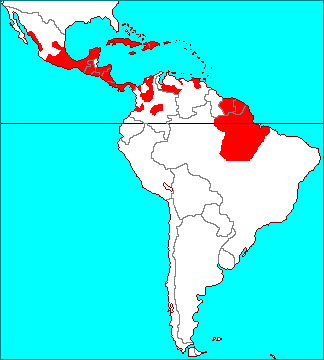
México, Guatemala, Honduras, El Salvador, Nicaragua, Costa Rica, Panama, Cuba, Jamaica, Haiti, Dominica, Puerto Rico, Colombia, Venezuela, Trinidad and Tobago, Suriname, Guiana, Brazil
México (Sinaloa, San Luis Potosí, Nayarit, Hidalgo, Vera Cruz, Puebla, Morelos, México, Michoacán, Guerrero, Oaxaca, Tabasco, Chiapas, Campeche, Yucatán, Quintana Roo)
Guatemala, Honduras, El Salvador, Nicaragua, Costa Rica, Panama, Cuba, Jamaica, Haiti, Dominica, Puerto Rico
Colombia (Magdalena, Bolívar, Antioquia, Meta, Valle del Cauca)
Venezuela (Nueva Esparta, Sucre, Monagas, Distrito Federal, Aragua, Merida, Barinas, Apure)
Trinidad and Tobago, Suriname, Guiana
Brazil (Amapá, Pará)
0 - 1,880 m elevation
Epiphytic
Tillandsia fasciculata
Tillandsia (Tillandsia) fasciculata Swartz (1788)
- [ Etymology ] fascicularis in Latin (bundle of)
- The rosette is composed of relatively rigid and narrow leaves. There are many variety of size and flowers.
- So called Tillandsia fasciculata in Mexico were re-classifed to Tillandsia fasciculata (sensu stricto), Tillandsia maritima (= Tillandsia roland-gosselini), Tillandsia hubertiana, Tillandsia flavobracteata, Tillandsia jaliscomonticola, Tillandsia x rothii, Tillandsia macvaughii, Tillandsia marabascoensis, Tillandsia zoquensis, Tillandsia grossispicata, Tillandsia inopinata.
- [ Width ] 40 cm
- [ Height ] 50 cm
- [ Petal ] Violet
Classification
- [ Genus ] Tillandsia
- [ Subgenus ] Tillandsia
- [ Species ] fasciculata
- [ Variety ]
- bogotensis => Tillandsia fasciculata
- clavispica (Clavated spikes, Long bracts)
- convexispica => Tillandsia fasciculata
- densispica (Large glabrous spikes)
- fasciculata (Long flat spikes)
- floridana => Tillandsia x floridana
- latispica => Tillandsia fasciculata
- laxispica (Lax inflorescences)
- pendulispica (Pendulous inflorescences)
- rotundata => Tillandsia rotundata
- uncispica (Linear-lanceolate spikes)
- venosispica (Nerved and beaked floral bracts)
- [ Form ]
- alba (White flowers)
- [ Synonyms ]
- Cardinal ariplant
- Giant ariplant
- Tillandsia compressa var. oligostachya Baker ex André (1888)
- Tillandsia glaucophylla (Hooker) Baker (1887)
- Tillandsia pungens Mez (1896)
Cultivation
Informations summarized here are based on our experiences, and TrekGEO does not guarantee the results by cultivating in the same or similar conditions described here. Even a species of Tillandsia differs substantially between individuals, and is very sensitive in changes of environments. Applicatons of any idea inspired by this site should be at your own risks.
2nd Plant
- Cultivation condition
- Partial sun, Dipping, Shelving, Winter Heater
- Jul 2025 It keeps growing.
- Up to this point
- Partial sun, Long soaking, Shelving, AC / Heater
- Nov 2021 It keeps growing.
- Up to this point
- Partial shade, Long soaking, Shelving, Summer AC
- Apr 2020 It keeps growing.
- Aug 2018 Roots began to grow.
- Up to this point
- Partial shade, Long soaking, Shelving, Indoors
- Apr 2018 It keeps growing.
- Oct 2017 Roots began to grow.
- Aug 2015 Good condition.
1st Plant
- Cultivation condition
- Partial shade, Long soaking, Shelving, Indoors
- Jul 2008 The growing point of the foliage is standing up.
- Jun 2008 Five roots began to grow.
- Mar 2008 Leaves turned purplish.
- Nov 2007 Roots began to grow.
- Jul 2007 Roots began to grow.
- Oct 2006 Moved to another site. Cultivation condition is almost same as the previous site.
- Jul 2006 Roots began to grow.
- Jan 2006 Leaves turned purplish.
- Jul 2005 Many roots are growing.
- Sep 2004 Roots began to tangled up.
- Aug 2004 The temperature rises above 30 °C for 40 days, and the highest temperature was over 39 °C.
- Jul 2004 The original foliage was removed as it began to die.
- Jun 2004 Roots began to grow.
- Jun 2004 An offset is growing at the base of the foliage.